NRS-490 - Early Skin-to-Skin Contact's Impact on Newborn Health
VerifiedAdded on 2023/01/17
|17
|4256
|48
Report
AI Summary
This report, prepared for NRS-490 at Grand Canyon University, investigates the impact of early skin-to-skin contact (SSC) on newborn health. The paper explores the benefits of SSC, including reduced hypothermia, improved breastfeeding, and enhanced mother-child bonding. It addresses the barriers to implementing SSC, such as lack of knowledge and motivation among healthcare professionals, and proposes strategies for successful implementation within a 10-week timeframe. The report includes a PICOT question to guide the research, a literature search strategy, and an analysis of relevant research articles. The paper emphasizes the importance of teamwork among nurses, doctors, and mothers to achieve the desired outcomes of improved infant health and maternal well-being. The report highlights the role of nurses in promoting SSC and the need for education and support to overcome implementation challenges. The paper also includes a literature evaluation table and discusses the limitations of the research studies analyzed.
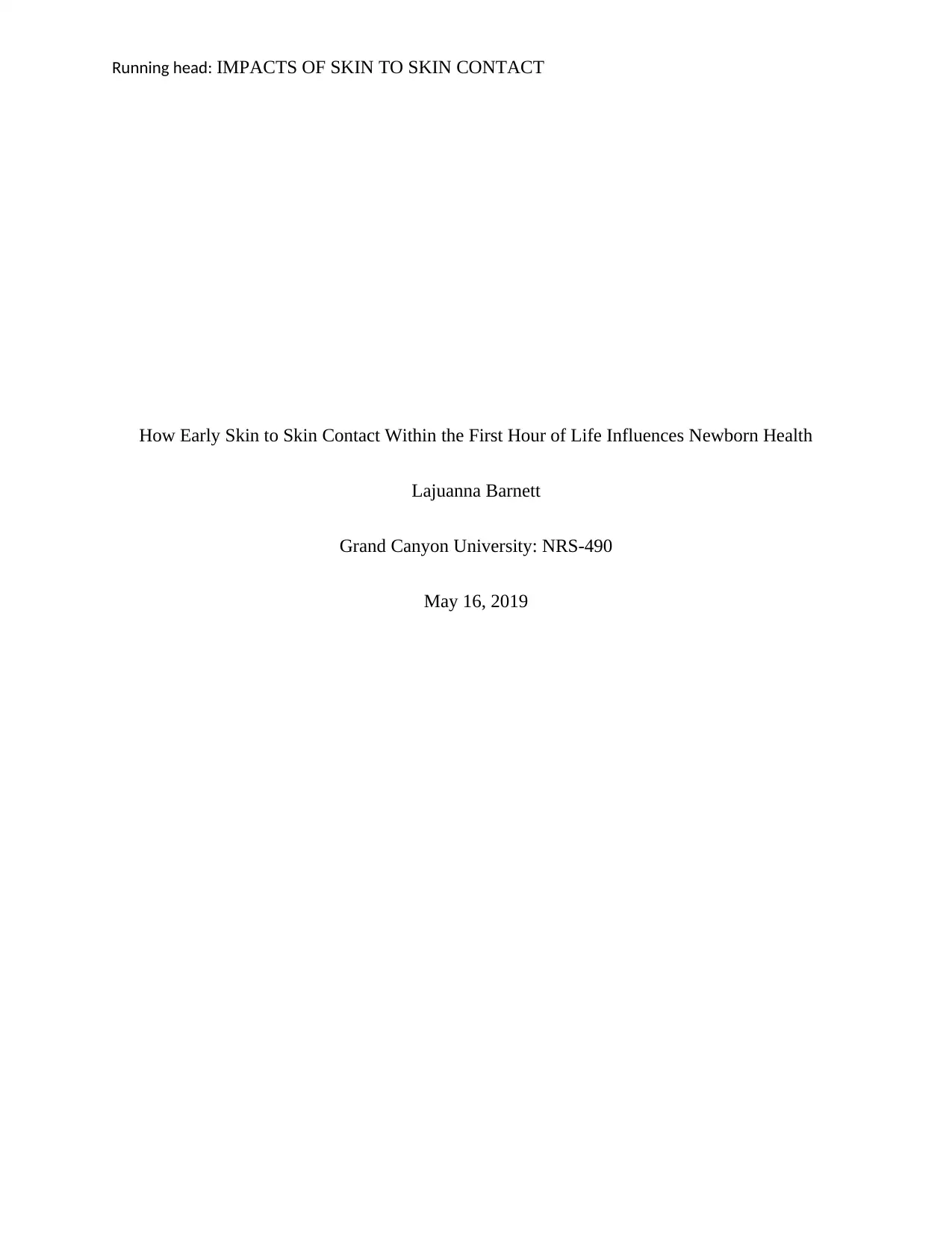
Running head: IMPACTS OF SKIN TO SKIN CONTACT
How Early Skin to Skin Contact Within the First Hour of Life Influences Newborn Health
Lajuanna Barnett
Grand Canyon University: NRS-490
May 16, 2019
How Early Skin to Skin Contact Within the First Hour of Life Influences Newborn Health
Lajuanna Barnett
Grand Canyon University: NRS-490
May 16, 2019
Paraphrase This Document
Need a fresh take? Get an instant paraphrase of this document with our AI Paraphraser
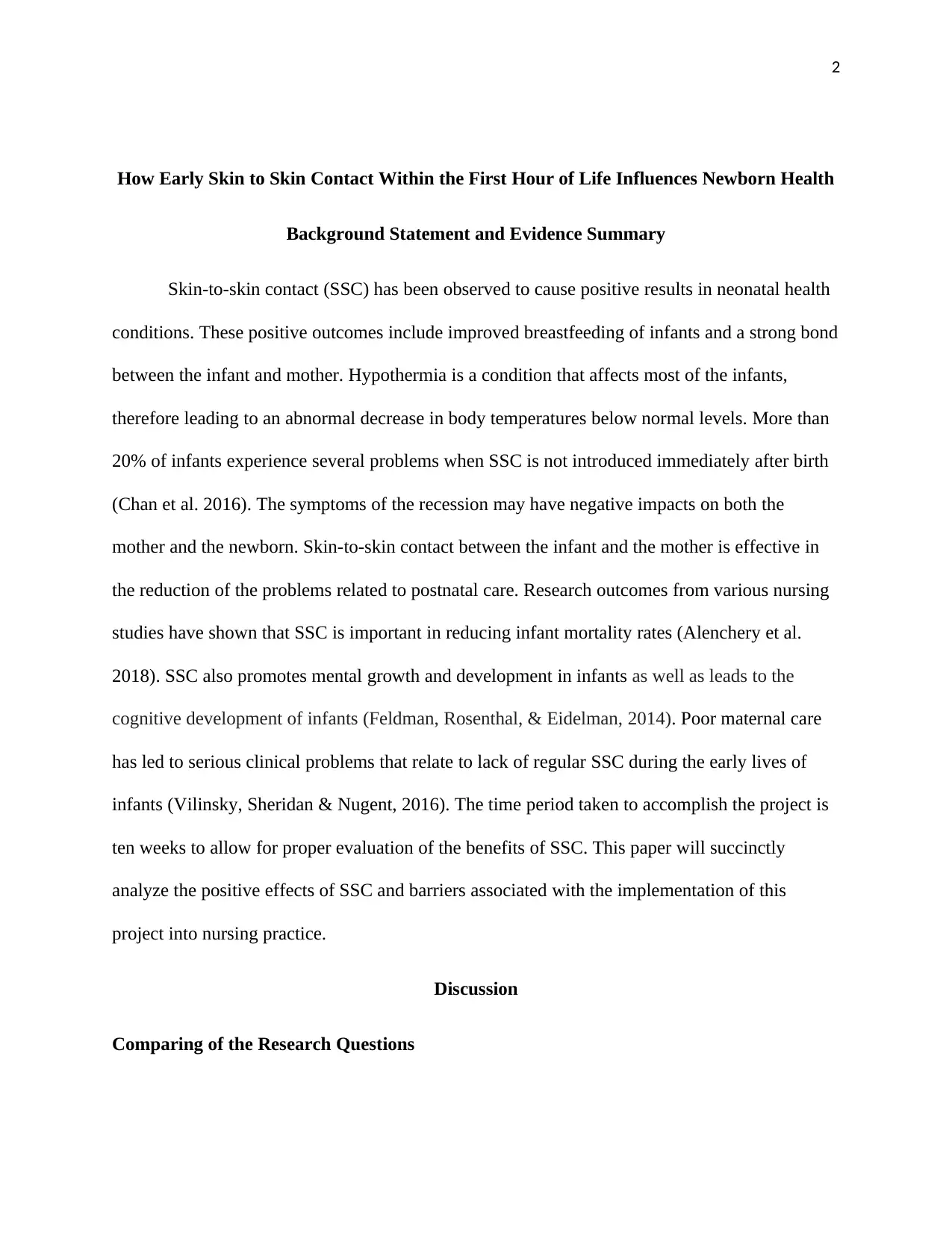
2
How Early Skin to Skin Contact Within the First Hour of Life Influences Newborn Health
Background Statement and Evidence Summary
Skin-to-skin contact (SSC) has been observed to cause positive results in neonatal health
conditions. These positive outcomes include improved breastfeeding of infants and a strong bond
between the infant and mother. Hypothermia is a condition that affects most of the infants,
therefore leading to an abnormal decrease in body temperatures below normal levels. More than
20% of infants experience several problems when SSC is not introduced immediately after birth
(Chan et al. 2016). The symptoms of the recession may have negative impacts on both the
mother and the newborn. Skin-to-skin contact between the infant and the mother is effective in
the reduction of the problems related to postnatal care. Research outcomes from various nursing
studies have shown that SSC is important in reducing infant mortality rates (Alenchery et al.
2018). SSC also promotes mental growth and development in infants as well as leads to the
cognitive development of infants (Feldman, Rosenthal, & Eidelman, 2014). Poor maternal care
has led to serious clinical problems that relate to lack of regular SSC during the early lives of
infants (Vilinsky, Sheridan & Nugent, 2016). The time period taken to accomplish the project is
ten weeks to allow for proper evaluation of the benefits of SSC. This paper will succinctly
analyze the positive effects of SSC and barriers associated with the implementation of this
project into nursing practice.
Discussion
Comparing of the Research Questions
How Early Skin to Skin Contact Within the First Hour of Life Influences Newborn Health
Background Statement and Evidence Summary
Skin-to-skin contact (SSC) has been observed to cause positive results in neonatal health
conditions. These positive outcomes include improved breastfeeding of infants and a strong bond
between the infant and mother. Hypothermia is a condition that affects most of the infants,
therefore leading to an abnormal decrease in body temperatures below normal levels. More than
20% of infants experience several problems when SSC is not introduced immediately after birth
(Chan et al. 2016). The symptoms of the recession may have negative impacts on both the
mother and the newborn. Skin-to-skin contact between the infant and the mother is effective in
the reduction of the problems related to postnatal care. Research outcomes from various nursing
studies have shown that SSC is important in reducing infant mortality rates (Alenchery et al.
2018). SSC also promotes mental growth and development in infants as well as leads to the
cognitive development of infants (Feldman, Rosenthal, & Eidelman, 2014). Poor maternal care
has led to serious clinical problems that relate to lack of regular SSC during the early lives of
infants (Vilinsky, Sheridan & Nugent, 2016). The time period taken to accomplish the project is
ten weeks to allow for proper evaluation of the benefits of SSC. This paper will succinctly
analyze the positive effects of SSC and barriers associated with the implementation of this
project into nursing practice.
Discussion
Comparing of the Research Questions
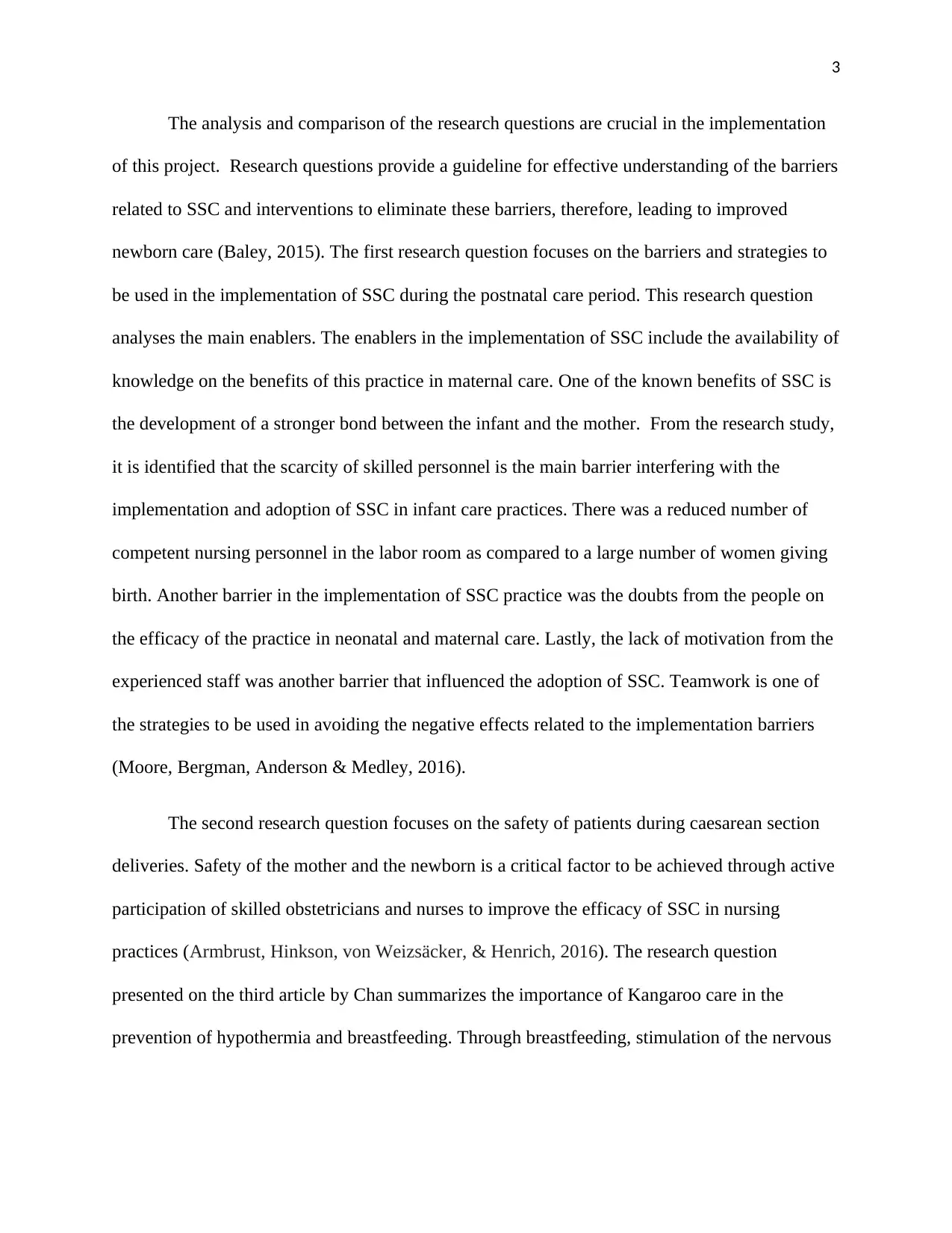
3
The analysis and comparison of the research questions are crucial in the implementation
of this project. Research questions provide a guideline for effective understanding of the barriers
related to SSC and interventions to eliminate these barriers, therefore, leading to improved
newborn care (Baley, 2015). The first research question focuses on the barriers and strategies to
be used in the implementation of SSC during the postnatal care period. This research question
analyses the main enablers. The enablers in the implementation of SSC include the availability of
knowledge on the benefits of this practice in maternal care. One of the known benefits of SSC is
the development of a stronger bond between the infant and the mother. From the research study,
it is identified that the scarcity of skilled personnel is the main barrier interfering with the
implementation and adoption of SSC in infant care practices. There was a reduced number of
competent nursing personnel in the labor room as compared to a large number of women giving
birth. Another barrier in the implementation of SSC practice was the doubts from the people on
the efficacy of the practice in neonatal and maternal care. Lastly, the lack of motivation from the
experienced staff was another barrier that influenced the adoption of SSC. Teamwork is one of
the strategies to be used in avoiding the negative effects related to the implementation barriers
(Moore, Bergman, Anderson & Medley, 2016).
The second research question focuses on the safety of patients during caesarean section
deliveries. Safety of the mother and the newborn is a critical factor to be achieved through active
participation of skilled obstetricians and nurses to improve the efficacy of SSC in nursing
practices (Armbrust, Hinkson, von Weizsäcker, & Henrich, 2016). The research question
presented on the third article by Chan summarizes the importance of Kangaroo care in the
prevention of hypothermia and breastfeeding. Through breastfeeding, stimulation of the nervous
The analysis and comparison of the research questions are crucial in the implementation
of this project. Research questions provide a guideline for effective understanding of the barriers
related to SSC and interventions to eliminate these barriers, therefore, leading to improved
newborn care (Baley, 2015). The first research question focuses on the barriers and strategies to
be used in the implementation of SSC during the postnatal care period. This research question
analyses the main enablers. The enablers in the implementation of SSC include the availability of
knowledge on the benefits of this practice in maternal care. One of the known benefits of SSC is
the development of a stronger bond between the infant and the mother. From the research study,
it is identified that the scarcity of skilled personnel is the main barrier interfering with the
implementation and adoption of SSC in infant care practices. There was a reduced number of
competent nursing personnel in the labor room as compared to a large number of women giving
birth. Another barrier in the implementation of SSC practice was the doubts from the people on
the efficacy of the practice in neonatal and maternal care. Lastly, the lack of motivation from the
experienced staff was another barrier that influenced the adoption of SSC. Teamwork is one of
the strategies to be used in avoiding the negative effects related to the implementation barriers
(Moore, Bergman, Anderson & Medley, 2016).
The second research question focuses on the safety of patients during caesarean section
deliveries. Safety of the mother and the newborn is a critical factor to be achieved through active
participation of skilled obstetricians and nurses to improve the efficacy of SSC in nursing
practices (Armbrust, Hinkson, von Weizsäcker, & Henrich, 2016). The research question
presented on the third article by Chan summarizes the importance of Kangaroo care in the
prevention of hypothermia and breastfeeding. Through breastfeeding, stimulation of the nervous
⊘ This is a preview!⊘
Do you want full access?
Subscribe today to unlock all pages.

Trusted by 1+ million students worldwide
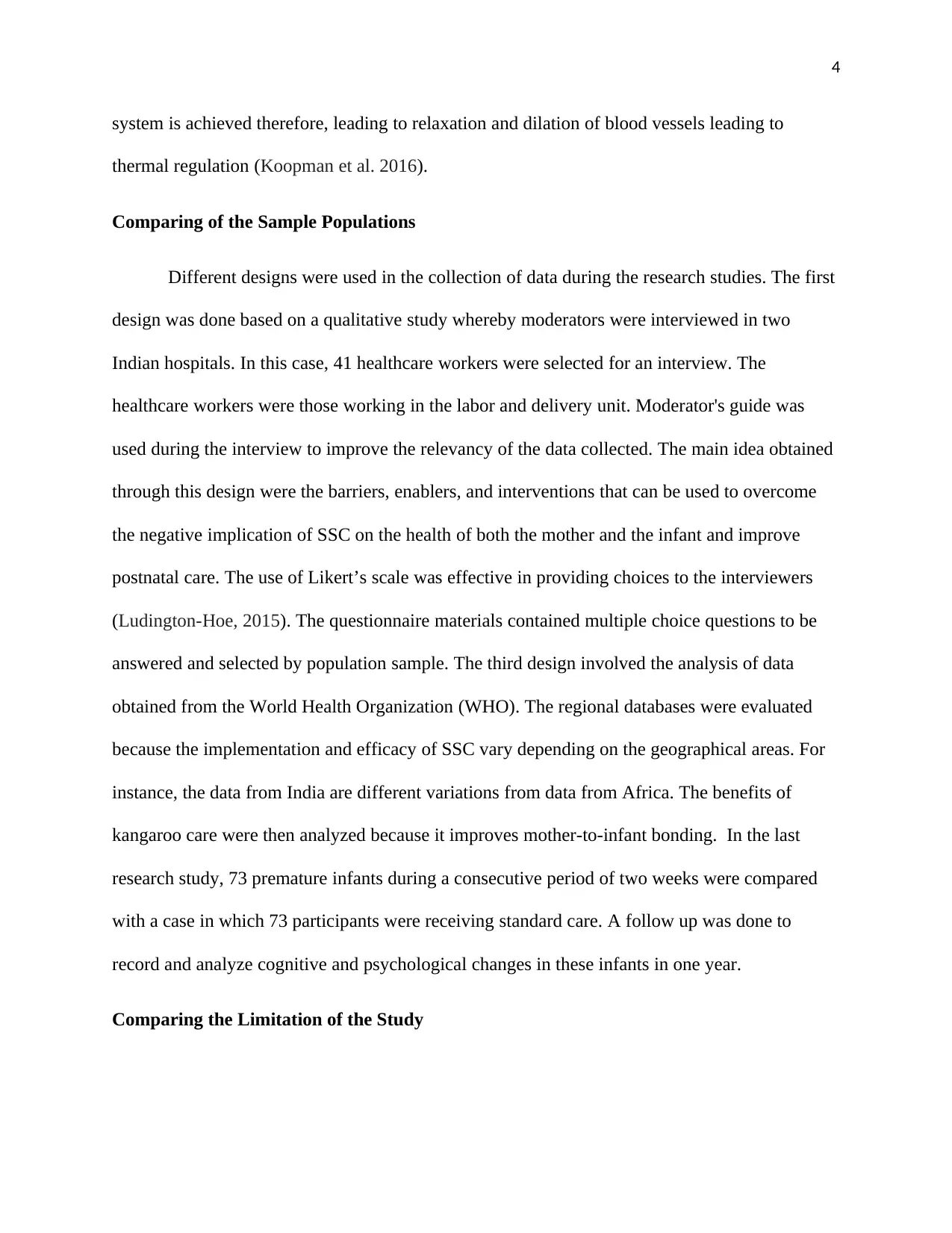
4
system is achieved therefore, leading to relaxation and dilation of blood vessels leading to
thermal regulation (Koopman et al. 2016).
Comparing of the Sample Populations
Different designs were used in the collection of data during the research studies. The first
design was done based on a qualitative study whereby moderators were interviewed in two
Indian hospitals. In this case, 41 healthcare workers were selected for an interview. The
healthcare workers were those working in the labor and delivery unit. Moderator's guide was
used during the interview to improve the relevancy of the data collected. The main idea obtained
through this design were the barriers, enablers, and interventions that can be used to overcome
the negative implication of SSC on the health of both the mother and the infant and improve
postnatal care. The use of Likert’s scale was effective in providing choices to the interviewers
(Ludington-Hoe, 2015). The questionnaire materials contained multiple choice questions to be
answered and selected by population sample. The third design involved the analysis of data
obtained from the World Health Organization (WHO). The regional databases were evaluated
because the implementation and efficacy of SSC vary depending on the geographical areas. For
instance, the data from India are different variations from data from Africa. The benefits of
kangaroo care were then analyzed because it improves mother-to-infant bonding. In the last
research study, 73 premature infants during a consecutive period of two weeks were compared
with a case in which 73 participants were receiving standard care. A follow up was done to
record and analyze cognitive and psychological changes in these infants in one year.
Comparing the Limitation of the Study
system is achieved therefore, leading to relaxation and dilation of blood vessels leading to
thermal regulation (Koopman et al. 2016).
Comparing of the Sample Populations
Different designs were used in the collection of data during the research studies. The first
design was done based on a qualitative study whereby moderators were interviewed in two
Indian hospitals. In this case, 41 healthcare workers were selected for an interview. The
healthcare workers were those working in the labor and delivery unit. Moderator's guide was
used during the interview to improve the relevancy of the data collected. The main idea obtained
through this design were the barriers, enablers, and interventions that can be used to overcome
the negative implication of SSC on the health of both the mother and the infant and improve
postnatal care. The use of Likert’s scale was effective in providing choices to the interviewers
(Ludington-Hoe, 2015). The questionnaire materials contained multiple choice questions to be
answered and selected by population sample. The third design involved the analysis of data
obtained from the World Health Organization (WHO). The regional databases were evaluated
because the implementation and efficacy of SSC vary depending on the geographical areas. For
instance, the data from India are different variations from data from Africa. The benefits of
kangaroo care were then analyzed because it improves mother-to-infant bonding. In the last
research study, 73 premature infants during a consecutive period of two weeks were compared
with a case in which 73 participants were receiving standard care. A follow up was done to
record and analyze cognitive and psychological changes in these infants in one year.
Comparing the Limitation of the Study
Paraphrase This Document
Need a fresh take? Get an instant paraphrase of this document with our AI Paraphraser
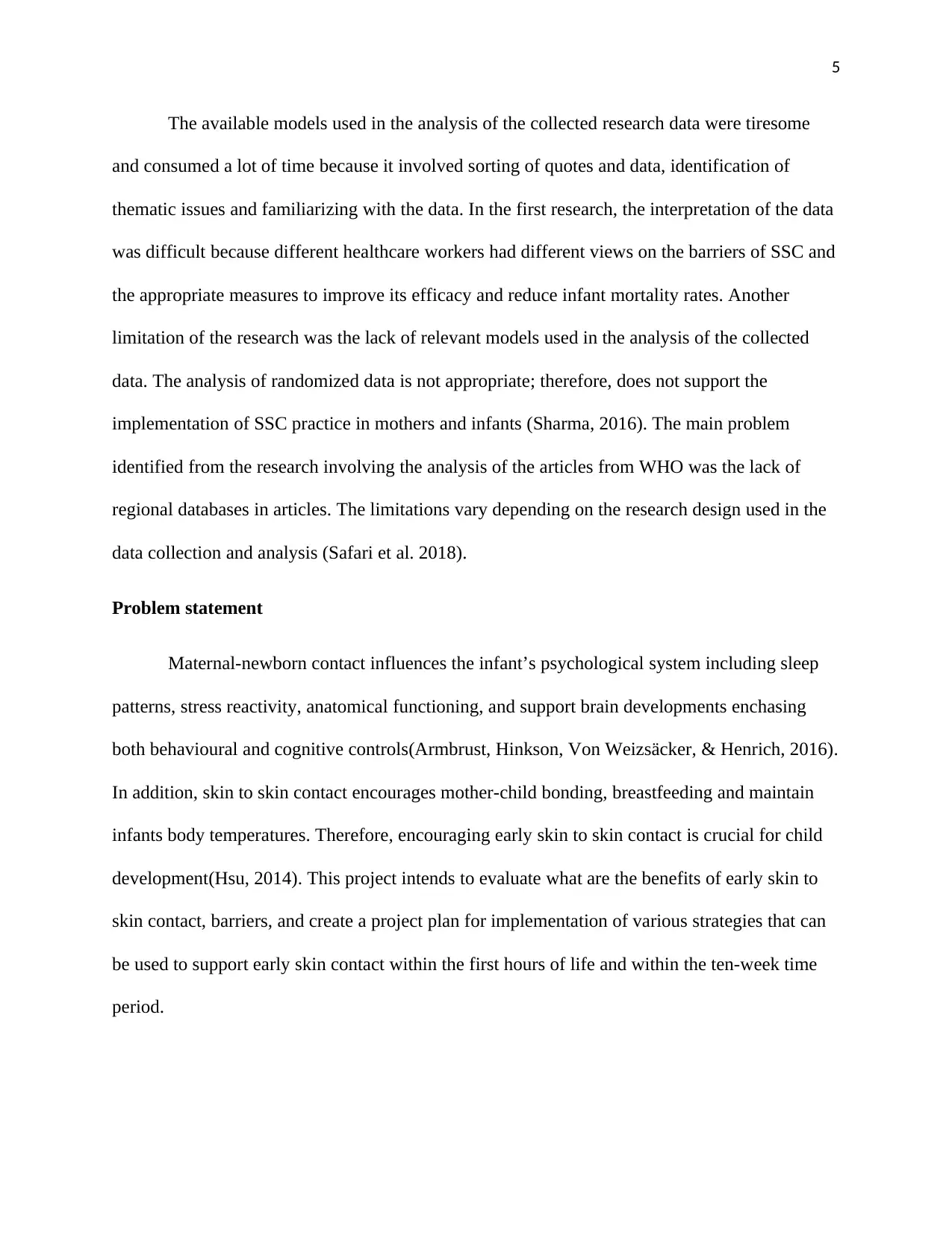
5
The available models used in the analysis of the collected research data were tiresome
and consumed a lot of time because it involved sorting of quotes and data, identification of
thematic issues and familiarizing with the data. In the first research, the interpretation of the data
was difficult because different healthcare workers had different views on the barriers of SSC and
the appropriate measures to improve its efficacy and reduce infant mortality rates. Another
limitation of the research was the lack of relevant models used in the analysis of the collected
data. The analysis of randomized data is not appropriate; therefore, does not support the
implementation of SSC practice in mothers and infants (Sharma, 2016). The main problem
identified from the research involving the analysis of the articles from WHO was the lack of
regional databases in articles. The limitations vary depending on the research design used in the
data collection and analysis (Safari et al. 2018).
Problem statement
Maternal-newborn contact influences the infant’s psychological system including sleep
patterns, stress reactivity, anatomical functioning, and support brain developments enchasing
both behavioural and cognitive controls(Armbrust, Hinkson, Von Weizsäcker, & Henrich, 2016).
In addition, skin to skin contact encourages mother-child bonding, breastfeeding and maintain
infants body temperatures. Therefore, encouraging early skin to skin contact is crucial for child
development(Hsu, 2014). This project intends to evaluate what are the benefits of early skin to
skin contact, barriers, and create a project plan for implementation of various strategies that can
be used to support early skin contact within the first hours of life and within the ten-week time
period.
The available models used in the analysis of the collected research data were tiresome
and consumed a lot of time because it involved sorting of quotes and data, identification of
thematic issues and familiarizing with the data. In the first research, the interpretation of the data
was difficult because different healthcare workers had different views on the barriers of SSC and
the appropriate measures to improve its efficacy and reduce infant mortality rates. Another
limitation of the research was the lack of relevant models used in the analysis of the collected
data. The analysis of randomized data is not appropriate; therefore, does not support the
implementation of SSC practice in mothers and infants (Sharma, 2016). The main problem
identified from the research involving the analysis of the articles from WHO was the lack of
regional databases in articles. The limitations vary depending on the research design used in the
data collection and analysis (Safari et al. 2018).
Problem statement
Maternal-newborn contact influences the infant’s psychological system including sleep
patterns, stress reactivity, anatomical functioning, and support brain developments enchasing
both behavioural and cognitive controls(Armbrust, Hinkson, Von Weizsäcker, & Henrich, 2016).
In addition, skin to skin contact encourages mother-child bonding, breastfeeding and maintain
infants body temperatures. Therefore, encouraging early skin to skin contact is crucial for child
development(Hsu, 2014). This project intends to evaluate what are the benefits of early skin to
skin contact, barriers, and create a project plan for implementation of various strategies that can
be used to support early skin contact within the first hours of life and within the ten-week time
period.
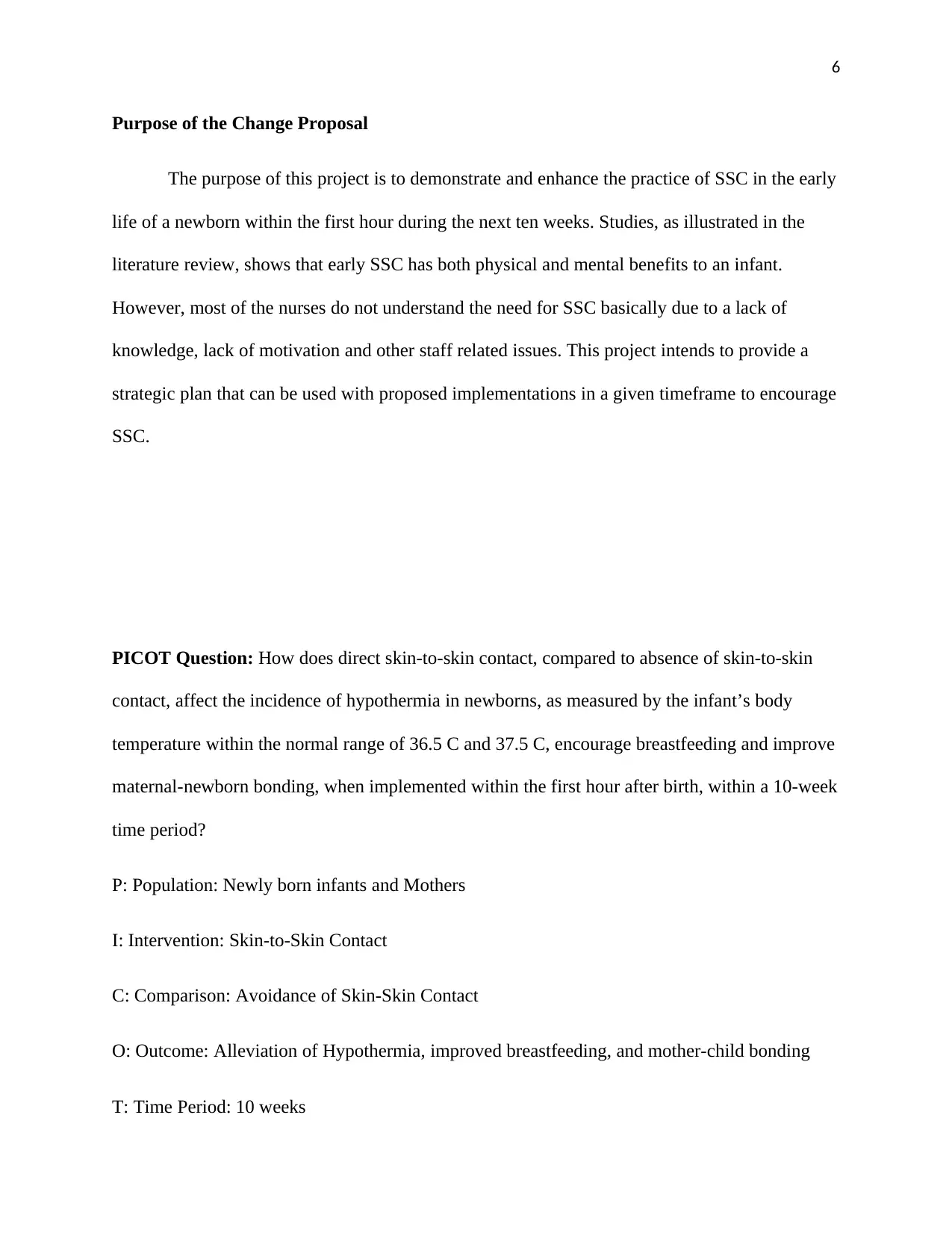
6
Purpose of the Change Proposal
The purpose of this project is to demonstrate and enhance the practice of SSC in the early
life of a newborn within the first hour during the next ten weeks. Studies, as illustrated in the
literature review, shows that early SSC has both physical and mental benefits to an infant.
However, most of the nurses do not understand the need for SSC basically due to a lack of
knowledge, lack of motivation and other staff related issues. This project intends to provide a
strategic plan that can be used with proposed implementations in a given timeframe to encourage
SSC.
PICOT Question: How does direct skin-to-skin contact, compared to absence of skin-to-skin
contact, affect the incidence of hypothermia in newborns, as measured by the infant’s body
temperature within the normal range of 36.5 C and 37.5 C, encourage breastfeeding and improve
maternal-newborn bonding, when implemented within the first hour after birth, within a 10-week
time period?
P: Population: Newly born infants and Mothers
I: Intervention: Skin-to-Skin Contact
C: Comparison: Avoidance of Skin-Skin Contact
O: Outcome: Alleviation of Hypothermia, improved breastfeeding, and mother-child bonding
T: Time Period: 10 weeks
Purpose of the Change Proposal
The purpose of this project is to demonstrate and enhance the practice of SSC in the early
life of a newborn within the first hour during the next ten weeks. Studies, as illustrated in the
literature review, shows that early SSC has both physical and mental benefits to an infant.
However, most of the nurses do not understand the need for SSC basically due to a lack of
knowledge, lack of motivation and other staff related issues. This project intends to provide a
strategic plan that can be used with proposed implementations in a given timeframe to encourage
SSC.
PICOT Question: How does direct skin-to-skin contact, compared to absence of skin-to-skin
contact, affect the incidence of hypothermia in newborns, as measured by the infant’s body
temperature within the normal range of 36.5 C and 37.5 C, encourage breastfeeding and improve
maternal-newborn bonding, when implemented within the first hour after birth, within a 10-week
time period?
P: Population: Newly born infants and Mothers
I: Intervention: Skin-to-Skin Contact
C: Comparison: Avoidance of Skin-Skin Contact
O: Outcome: Alleviation of Hypothermia, improved breastfeeding, and mother-child bonding
T: Time Period: 10 weeks
⊘ This is a preview!⊘
Do you want full access?
Subscribe today to unlock all pages.

Trusted by 1+ million students worldwide
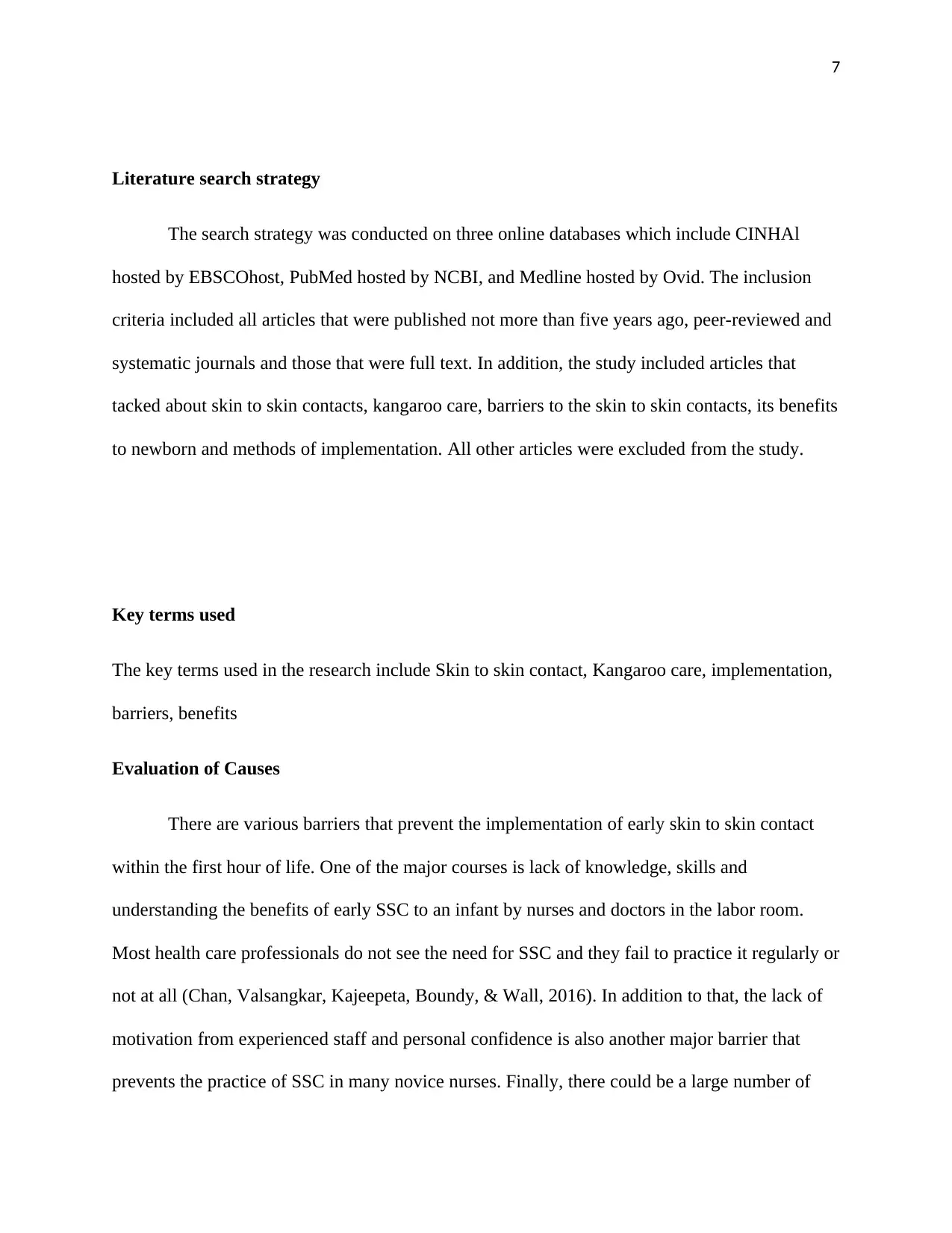
7
Literature search strategy
The search strategy was conducted on three online databases which include CINHAl
hosted by EBSCOhost, PubMed hosted by NCBI, and Medline hosted by Ovid. The inclusion
criteria included all articles that were published not more than five years ago, peer-reviewed and
systematic journals and those that were full text. In addition, the study included articles that
tacked about skin to skin contacts, kangaroo care, barriers to the skin to skin contacts, its benefits
to newborn and methods of implementation. All other articles were excluded from the study.
Key terms used
The key terms used in the research include Skin to skin contact, Kangaroo care, implementation,
barriers, benefits
Evaluation of Causes
There are various barriers that prevent the implementation of early skin to skin contact
within the first hour of life. One of the major courses is lack of knowledge, skills and
understanding the benefits of early SSC to an infant by nurses and doctors in the labor room.
Most health care professionals do not see the need for SSC and they fail to practice it regularly or
not at all (Chan, Valsangkar, Kajeepeta, Boundy, & Wall, 2016). In addition to that, the lack of
motivation from experienced staff and personal confidence is also another major barrier that
prevents the practice of SSC in many novice nurses. Finally, there could be a large number of
Literature search strategy
The search strategy was conducted on three online databases which include CINHAl
hosted by EBSCOhost, PubMed hosted by NCBI, and Medline hosted by Ovid. The inclusion
criteria included all articles that were published not more than five years ago, peer-reviewed and
systematic journals and those that were full text. In addition, the study included articles that
tacked about skin to skin contacts, kangaroo care, barriers to the skin to skin contacts, its benefits
to newborn and methods of implementation. All other articles were excluded from the study.
Key terms used
The key terms used in the research include Skin to skin contact, Kangaroo care, implementation,
barriers, benefits
Evaluation of Causes
There are various barriers that prevent the implementation of early skin to skin contact
within the first hour of life. One of the major courses is lack of knowledge, skills and
understanding the benefits of early SSC to an infant by nurses and doctors in the labor room.
Most health care professionals do not see the need for SSC and they fail to practice it regularly or
not at all (Chan, Valsangkar, Kajeepeta, Boundy, & Wall, 2016). In addition to that, the lack of
motivation from experienced staff and personal confidence is also another major barrier that
prevents the practice of SSC in many novice nurses. Finally, there could be a large number of
Paraphrase This Document
Need a fresh take? Get an instant paraphrase of this document with our AI Paraphraser
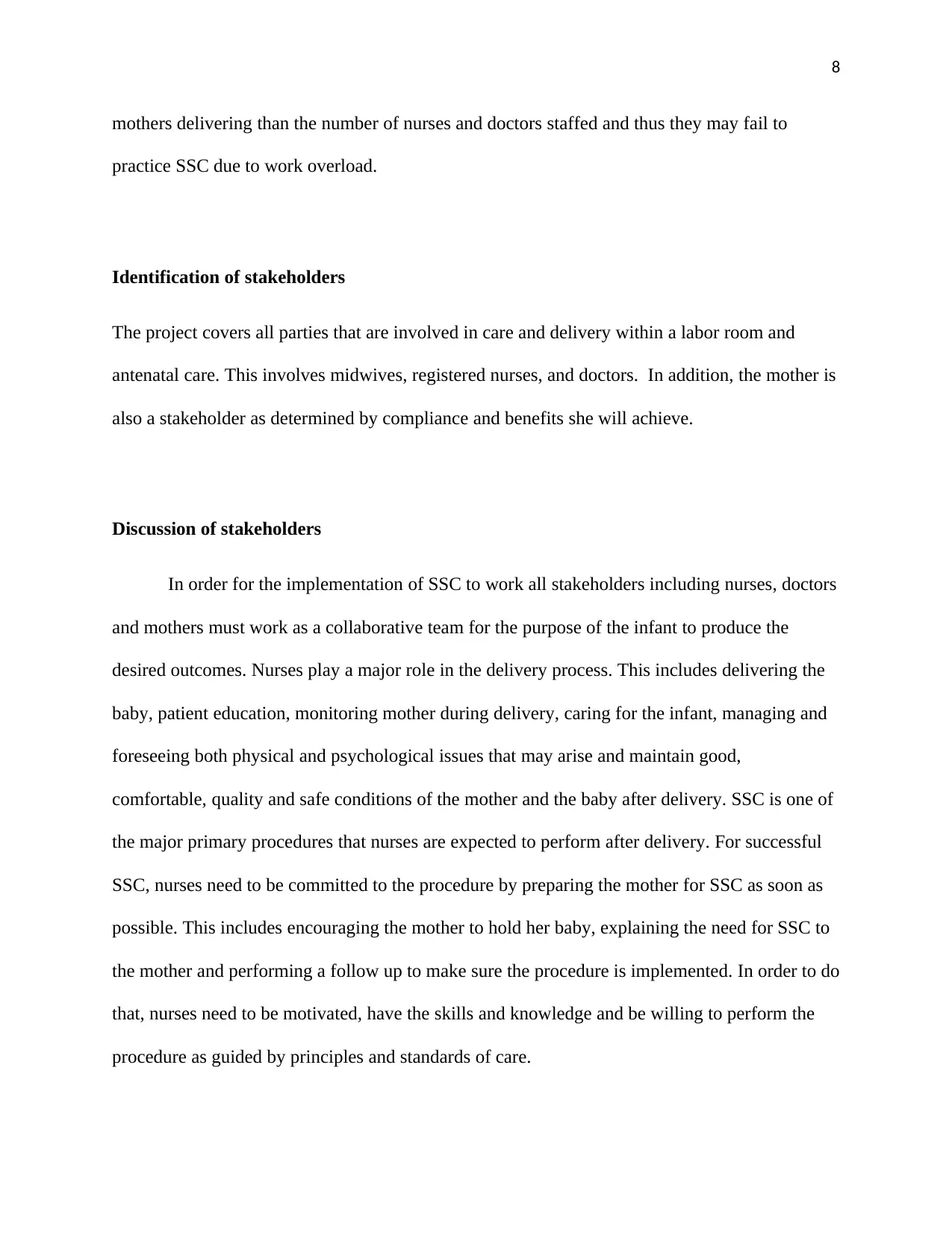
8
mothers delivering than the number of nurses and doctors staffed and thus they may fail to
practice SSC due to work overload.
Identification of stakeholders
The project covers all parties that are involved in care and delivery within a labor room and
antenatal care. This involves midwives, registered nurses, and doctors. In addition, the mother is
also a stakeholder as determined by compliance and benefits she will achieve.
Discussion of stakeholders
In order for the implementation of SSC to work all stakeholders including nurses, doctors
and mothers must work as a collaborative team for the purpose of the infant to produce the
desired outcomes. Nurses play a major role in the delivery process. This includes delivering the
baby, patient education, monitoring mother during delivery, caring for the infant, managing and
foreseeing both physical and psychological issues that may arise and maintain good,
comfortable, quality and safe conditions of the mother and the baby after delivery. SSC is one of
the major primary procedures that nurses are expected to perform after delivery. For successful
SSC, nurses need to be committed to the procedure by preparing the mother for SSC as soon as
possible. This includes encouraging the mother to hold her baby, explaining the need for SSC to
the mother and performing a follow up to make sure the procedure is implemented. In order to do
that, nurses need to be motivated, have the skills and knowledge and be willing to perform the
procedure as guided by principles and standards of care.
mothers delivering than the number of nurses and doctors staffed and thus they may fail to
practice SSC due to work overload.
Identification of stakeholders
The project covers all parties that are involved in care and delivery within a labor room and
antenatal care. This involves midwives, registered nurses, and doctors. In addition, the mother is
also a stakeholder as determined by compliance and benefits she will achieve.
Discussion of stakeholders
In order for the implementation of SSC to work all stakeholders including nurses, doctors
and mothers must work as a collaborative team for the purpose of the infant to produce the
desired outcomes. Nurses play a major role in the delivery process. This includes delivering the
baby, patient education, monitoring mother during delivery, caring for the infant, managing and
foreseeing both physical and psychological issues that may arise and maintain good,
comfortable, quality and safe conditions of the mother and the baby after delivery. SSC is one of
the major primary procedures that nurses are expected to perform after delivery. For successful
SSC, nurses need to be committed to the procedure by preparing the mother for SSC as soon as
possible. This includes encouraging the mother to hold her baby, explaining the need for SSC to
the mother and performing a follow up to make sure the procedure is implemented. In order to do
that, nurses need to be motivated, have the skills and knowledge and be willing to perform the
procedure as guided by principles and standards of care.
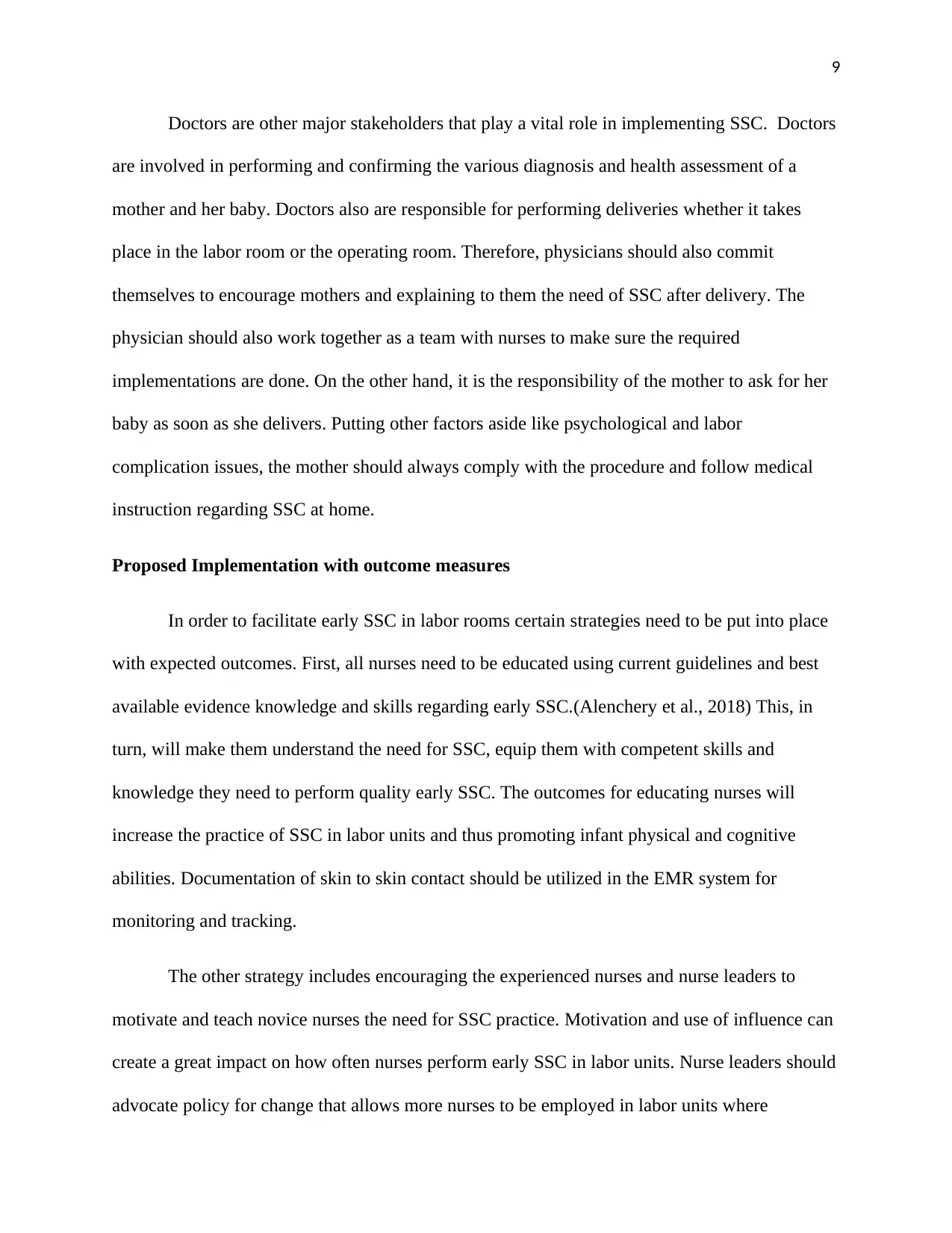
9
Doctors are other major stakeholders that play a vital role in implementing SSC. Doctors
are involved in performing and confirming the various diagnosis and health assessment of a
mother and her baby. Doctors also are responsible for performing deliveries whether it takes
place in the labor room or the operating room. Therefore, physicians should also commit
themselves to encourage mothers and explaining to them the need of SSC after delivery. The
physician should also work together as a team with nurses to make sure the required
implementations are done. On the other hand, it is the responsibility of the mother to ask for her
baby as soon as she delivers. Putting other factors aside like psychological and labor
complication issues, the mother should always comply with the procedure and follow medical
instruction regarding SSC at home.
Proposed Implementation with outcome measures
In order to facilitate early SSC in labor rooms certain strategies need to be put into place
with expected outcomes. First, all nurses need to be educated using current guidelines and best
available evidence knowledge and skills regarding early SSC.(Alenchery et al., 2018) This, in
turn, will make them understand the need for SSC, equip them with competent skills and
knowledge they need to perform quality early SSC. The outcomes for educating nurses will
increase the practice of SSC in labor units and thus promoting infant physical and cognitive
abilities. Documentation of skin to skin contact should be utilized in the EMR system for
monitoring and tracking.
The other strategy includes encouraging the experienced nurses and nurse leaders to
motivate and teach novice nurses the need for SSC practice. Motivation and use of influence can
create a great impact on how often nurses perform early SSC in labor units. Nurse leaders should
advocate policy for change that allows more nurses to be employed in labor units where
Doctors are other major stakeholders that play a vital role in implementing SSC. Doctors
are involved in performing and confirming the various diagnosis and health assessment of a
mother and her baby. Doctors also are responsible for performing deliveries whether it takes
place in the labor room or the operating room. Therefore, physicians should also commit
themselves to encourage mothers and explaining to them the need of SSC after delivery. The
physician should also work together as a team with nurses to make sure the required
implementations are done. On the other hand, it is the responsibility of the mother to ask for her
baby as soon as she delivers. Putting other factors aside like psychological and labor
complication issues, the mother should always comply with the procedure and follow medical
instruction regarding SSC at home.
Proposed Implementation with outcome measures
In order to facilitate early SSC in labor rooms certain strategies need to be put into place
with expected outcomes. First, all nurses need to be educated using current guidelines and best
available evidence knowledge and skills regarding early SSC.(Alenchery et al., 2018) This, in
turn, will make them understand the need for SSC, equip them with competent skills and
knowledge they need to perform quality early SSC. The outcomes for educating nurses will
increase the practice of SSC in labor units and thus promoting infant physical and cognitive
abilities. Documentation of skin to skin contact should be utilized in the EMR system for
monitoring and tracking.
The other strategy includes encouraging the experienced nurses and nurse leaders to
motivate and teach novice nurses the need for SSC practice. Motivation and use of influence can
create a great impact on how often nurses perform early SSC in labor units. Nurse leaders should
advocate policy for change that allows more nurses to be employed in labor units where
⊘ This is a preview!⊘
Do you want full access?
Subscribe today to unlock all pages.

Trusted by 1+ million students worldwide
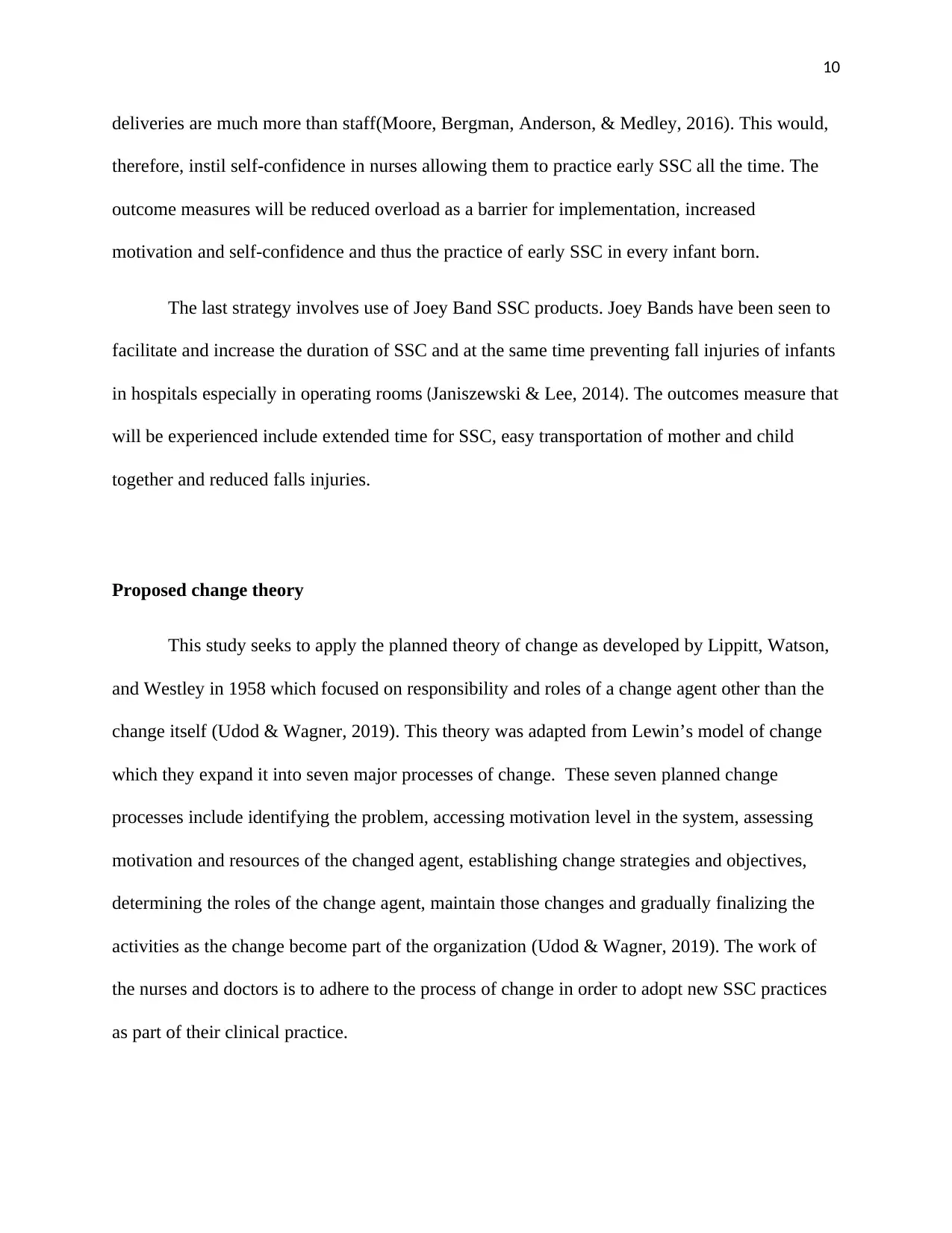
10
deliveries are much more than staff(Moore, Bergman, Anderson, & Medley, 2016). This would,
therefore, instil self-confidence in nurses allowing them to practice early SSC all the time. The
outcome measures will be reduced overload as a barrier for implementation, increased
motivation and self-confidence and thus the practice of early SSC in every infant born.
The last strategy involves use of Joey Band SSC products. Joey Bands have been seen to
facilitate and increase the duration of SSC and at the same time preventing fall injuries of infants
in hospitals especially in operating rooms (Janiszewski & Lee, 2014). The outcomes measure that
will be experienced include extended time for SSC, easy transportation of mother and child
together and reduced falls injuries.
Proposed change theory
This study seeks to apply the planned theory of change as developed by Lippitt, Watson,
and Westley in 1958 which focused on responsibility and roles of a change agent other than the
change itself (Udod & Wagner, 2019). This theory was adapted from Lewin’s model of change
which they expand it into seven major processes of change. These seven planned change
processes include identifying the problem, accessing motivation level in the system, assessing
motivation and resources of the changed agent, establishing change strategies and objectives,
determining the roles of the change agent, maintain those changes and gradually finalizing the
activities as the change become part of the organization (Udod & Wagner, 2019). The work of
the nurses and doctors is to adhere to the process of change in order to adopt new SSC practices
as part of their clinical practice.
deliveries are much more than staff(Moore, Bergman, Anderson, & Medley, 2016). This would,
therefore, instil self-confidence in nurses allowing them to practice early SSC all the time. The
outcome measures will be reduced overload as a barrier for implementation, increased
motivation and self-confidence and thus the practice of early SSC in every infant born.
The last strategy involves use of Joey Band SSC products. Joey Bands have been seen to
facilitate and increase the duration of SSC and at the same time preventing fall injuries of infants
in hospitals especially in operating rooms (Janiszewski & Lee, 2014). The outcomes measure that
will be experienced include extended time for SSC, easy transportation of mother and child
together and reduced falls injuries.
Proposed change theory
This study seeks to apply the planned theory of change as developed by Lippitt, Watson,
and Westley in 1958 which focused on responsibility and roles of a change agent other than the
change itself (Udod & Wagner, 2019). This theory was adapted from Lewin’s model of change
which they expand it into seven major processes of change. These seven planned change
processes include identifying the problem, accessing motivation level in the system, assessing
motivation and resources of the changed agent, establishing change strategies and objectives,
determining the roles of the change agent, maintain those changes and gradually finalizing the
activities as the change become part of the organization (Udod & Wagner, 2019). The work of
the nurses and doctors is to adhere to the process of change in order to adopt new SSC practices
as part of their clinical practice.
Paraphrase This Document
Need a fresh take? Get an instant paraphrase of this document with our AI Paraphraser

11
Barriers to implementation
The only barrier of implementation is the failure of nurses and doctor to adhere to the
proposed implementation. Once all nurses and doctors accept to be the agents of change and
implement the required strategies, early SSC practice will be part of their professional practice.
Barriers to implementation
The only barrier of implementation is the failure of nurses and doctor to adhere to the
proposed implementation. Once all nurses and doctors accept to be the agents of change and
implement the required strategies, early SSC practice will be part of their professional practice.
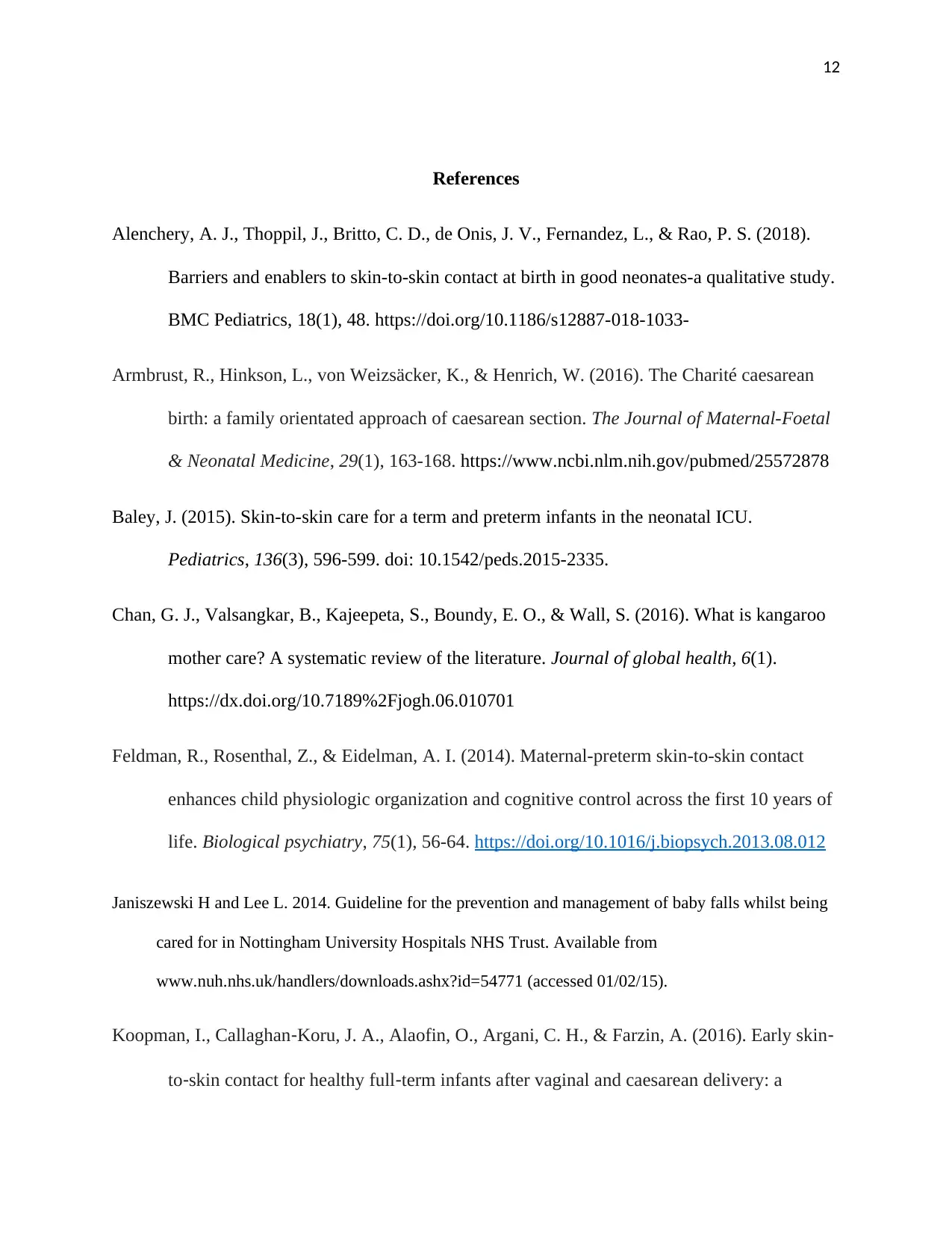
12
References
Alenchery, A. J., Thoppil, J., Britto, C. D., de Onis, J. V., Fernandez, L., & Rao, P. S. (2018).
Barriers and enablers to skin-to-skin contact at birth in good neonates-a qualitative study.
BMC Pediatrics, 18(1), 48. https://doi.org/10.1186/s12887-018-1033-
Armbrust, R., Hinkson, L., von Weizsäcker, K., & Henrich, W. (2016). The Charité caesarean
birth: a family orientated approach of caesarean section. The Journal of Maternal-Foetal
& Neonatal Medicine, 29(1), 163-168. https://www.ncbi.nlm.nih.gov/pubmed/25572878
Baley, J. (2015). Skin-to-skin care for a term and preterm infants in the neonatal ICU.
Pediatrics, 136(3), 596-599. doi: 10.1542/peds.2015-2335.
Chan, G. J., Valsangkar, B., Kajeepeta, S., Boundy, E. O., & Wall, S. (2016). What is kangaroo
mother care? A systematic review of the literature. Journal of global health, 6(1).
https://dx.doi.org/10.7189%2Fjogh.06.010701
Feldman, R., Rosenthal, Z., & Eidelman, A. I. (2014). Maternal-preterm skin-to-skin contact
enhances child physiologic organization and cognitive control across the first 10 years of
life. Biological psychiatry, 75(1), 56-64. https://doi.org/10.1016/j.biopsych.2013.08.012
Janiszewski H and Lee L. 2014. Guideline for the prevention and management of baby falls whilst being
cared for in Nottingham University Hospitals NHS Trust. Available from
www.nuh.nhs.uk/handlers/downloads.ashx?id=54771 (accessed 01/02/15).
Koopman, I., Callaghan‐Koru, J. A., Alaofin, O., Argani, C. H., & Farzin, A. (2016). Early skin‐
to‐skin contact for healthy full‐term infants after vaginal and caesarean delivery: a
References
Alenchery, A. J., Thoppil, J., Britto, C. D., de Onis, J. V., Fernandez, L., & Rao, P. S. (2018).
Barriers and enablers to skin-to-skin contact at birth in good neonates-a qualitative study.
BMC Pediatrics, 18(1), 48. https://doi.org/10.1186/s12887-018-1033-
Armbrust, R., Hinkson, L., von Weizsäcker, K., & Henrich, W. (2016). The Charité caesarean
birth: a family orientated approach of caesarean section. The Journal of Maternal-Foetal
& Neonatal Medicine, 29(1), 163-168. https://www.ncbi.nlm.nih.gov/pubmed/25572878
Baley, J. (2015). Skin-to-skin care for a term and preterm infants in the neonatal ICU.
Pediatrics, 136(3), 596-599. doi: 10.1542/peds.2015-2335.
Chan, G. J., Valsangkar, B., Kajeepeta, S., Boundy, E. O., & Wall, S. (2016). What is kangaroo
mother care? A systematic review of the literature. Journal of global health, 6(1).
https://dx.doi.org/10.7189%2Fjogh.06.010701
Feldman, R., Rosenthal, Z., & Eidelman, A. I. (2014). Maternal-preterm skin-to-skin contact
enhances child physiologic organization and cognitive control across the first 10 years of
life. Biological psychiatry, 75(1), 56-64. https://doi.org/10.1016/j.biopsych.2013.08.012
Janiszewski H and Lee L. 2014. Guideline for the prevention and management of baby falls whilst being
cared for in Nottingham University Hospitals NHS Trust. Available from
www.nuh.nhs.uk/handlers/downloads.ashx?id=54771 (accessed 01/02/15).
Koopman, I., Callaghan‐Koru, J. A., Alaofin, O., Argani, C. H., & Farzin, A. (2016). Early skin‐
to‐skin contact for healthy full‐term infants after vaginal and caesarean delivery: a
⊘ This is a preview!⊘
Do you want full access?
Subscribe today to unlock all pages.

Trusted by 1+ million students worldwide
1 out of 17
Related Documents
Your All-in-One AI-Powered Toolkit for Academic Success.
+13062052269
info@desklib.com
Available 24*7 on WhatsApp / Email
![[object Object]](/_next/static/media/star-bottom.7253800d.svg)
Unlock your academic potential
Copyright © 2020–2025 A2Z Services. All Rights Reserved. Developed and managed by ZUCOL.





